Abstract
The article deals with the semantic-pragmatic, morphological and syntactic parameters of the lexeme "still", which, depending on the context and functions, can act as an adverb, particle or conjunction. Changes in the morphological status of individual lexemes, the ambiguity of structural and semantic characteristics that arise due to changes in the syntagmatic environment, lead to the emergence of grammatical homonyms or morphological syncretic units. Particles as a grammatical class of functional words are components of many homocomplexes in the Ukrainian language. Adverbs are the most productive basis for the forming of homonymous derivative particles. Changes in the semantic and functional loading of the lexeme "still" related to the peculiarities of the syntagmatic environment, synonymous series of components of the analyzed homocomplex, syntactic functions, positional fixation of this lexeme as a part of the syntaxeme have been alalyzed. In the grammatical sphere of the adverb, the analyzed word appears in the adverbial position, expressing a number of temporal meanings: ‘in addition to the same’ (synonyms – again, repeatedly), ‘time sequence of certain events’ and ‘duration of actions’ (synonyms – until, so far), ‘premature implementation of a certain action in relation to others’ (in combination with temporal actualizers). Loss of the ability to nominate a non-procedural feature of another feature and perform an adverbial syntactic function leads to the transition of the adverb still into the functional sphere of particles. Besides the semantic feature of additionality and gradation, the analyzed particle (most often in the structure of stable constructions – still more, still again, still would again, still would not, etc.) is an expression of various semantic and pragmatic meanings: ‘negative assessment of a certain phenomenon’, ‘introduction of an additional component’, ‘confident confirmation of something’, ‘categorical objection to certain information’. As a component of stable constructions, such as still more, and still again, and still more again the lexeme still, depending on the context can fall into the syntactic sphere of the conjunction and become an expression of gradational semantic-syntactic relations, combining homogeneous parts of a sentence or predicative parts as conjunctions.
References
Бацевич Ф. Частки української мови як дискурсивні слова. Львів : ПАІС, 2014. 288 с.
Бондаренко Л. В. Склад та комунікативні функції вторинних часток : автореф. дис. ... канд. філол. наук : 10.02.01. Кіровоград, 2005. 20 с.
Высоцкая И В. Синкретизм в системе частей речи современного русского языка. Москва : МПГУ, 2006. 304 с.
Глібчук Н., Добосевич У. Проблеми міжчастиномовної омонімії в сучасній українській літературній мові. Вісник Львівського університету. Серія філологічна. Випуск 50. Львів, 2010. С. 386–403.
Головня А. И. Омонимия как системная категория языка: монография. Минск : БГУ, 2007. 132 с.
Данилюк І. Г. Синкретизм у системі частин мови : автореф. дис. ... на здобуття канд. філол. наук : 10.02.01. Донецьк, 2006. 20 с.
Джочка І. Семантичні та функціональні особливості граматичних омонімів ТАМ і ТУТ в українській мові. Українознавчі студії. 2019. № 20. С. 81–92.
Костусяк Н. М. Структура міжрівневих категорій сучасної української мови: монографія. Луцьк : Волин. нац. ун-т ім. Лесі Українки, 2012. 452 с.
Кочерган М. П. Слово і контекст. Львів, 1980. 184 с.
Кушлик О. Особливості функціонування вторинних часток ЩЕ і ВЖЕ в українській мові. Гуманітарний вісник. Серія: Іноземна філологія. Число 12. Черкаси : ЧДТУ, 2008. Т. 2. С. 88–91.
Леденев Ю. И. Состав и функциональные особенности класса неполнозначных слов в современном русском литературном языке: автореф. дисс. … докт. филол. наук. Москва, 1973. 35 с.
Лисиченко Л. А. Лексикологія сучасної української мови. Семантична структура слова. Харків : Вид-во при Харк. ун-ті «Вища школа», 1977. 114 с.
Соколова С. В. Транспозиційні передумови розвитку функціональної омонімії в українській мові (на матеріалі лексико-граматичного класу прислівників). Київ : «Альфа-М», 2010. 207 с.
Тараненко О. О. Омоніми. Українська мова: енциклопедія. Київ : Українська енциклопедія ім. М. П. Бажана, 2000. С. 402.
Шипнівська О. О. Міжчастиномовна морфологічна омонімія сучасної української мови. Київ : «Центр учбової літератури», 2020. 192 с.
СМО – Глібчук Н. М., Добосевич У. Б. Словник міжчастиномовних омонімів сучасної української мови. Львів : Апріорі, 2016. 638 с.
ГСУМ – Городенська К. Г. Граматичний словник української мови : Сполучники. Київ – Херсон, 2007. 340 с.
Забужко – Забужко О. Музей покинутих секретів. https://www.ukrlib.com.ua/books/printit.php?tid=2745 (дата звернення: 15.04.2021)
СЧМС – Загнітко А., Каратаєва А. Словник часток : матеріали і статті. Донецьк : ДонНУ, 2012. 381 с.
Іваничук – Іваничук Р. Бо війна – війною. https://www.ukrlib.com.ua/books/printit.php?tid=7151 (дата звернення: 15.04.2021)
Кокотюха, ТКС – Кокотюха А. Таємниця козацького скарбу. https://www.ukrlib.com.ua/books/printit.php?tid= 17520 (дата звернення: 15.04.2021)
Кокотюха А. Шукачі скарбів. https://coollib.com/b/287173-andriy-anatoliyovich-kokotyuha-shukachi-skarbiv/ read (дата звернення: 15.04.2021)
Лучик А. Словник еквівалентів слова української мови. К. : Вид. дім «Києво-Могилянська академія», 2008. 174 с.
СУМ – Словник української мови: у 11 т. Т. 11: Х–Ь. Київ : Наук. думка, 1980. 699 с.
Тютюнник – Тютюнник Г. Вир. https://www.ukrlib.com.ua/books/printitzip.php?tid=464 (дата звернення: 15.04.2021)

